
The Samsung Gear Fit is part fitness tracker, part smart wearable — a device that has the potential to solve the conundrum of smartwatches that attempt to cram too many features into too small a package. With an attractive design, reasonable price point, and the backing of Samsung’s hit line of Galaxy smartphones, the Fit has all the measurables to finish first. Does its training pay off in a victory? Read on to find out.
Smartwatch design done right
We have had a lot to say about Samsung’s design choices over the past few years. Whether it be the tacky faux-leather of the Galaxy Note 3, the cheap plastic construction of the Galaxy S line, or the clunky aesthetics of the original Galaxy Gear (and to a lesser degree the new line of Gear smartwatches), Samsung has continually missed the mark when it comes to aesthetics. The Gear Fit is a rare exception to the trend.
That isn’t to say the Fit is a marvel of design and engineering. Rather, the Fit borrows from the established look and feel of previous fitness trackers like the FitBit Force, Jawbone UP and Nike FuelBand, mixing in a few tasteful elements that are pure Samsung — remember, “tasteful” is a word not typically found in Samsung’s design dictionary.
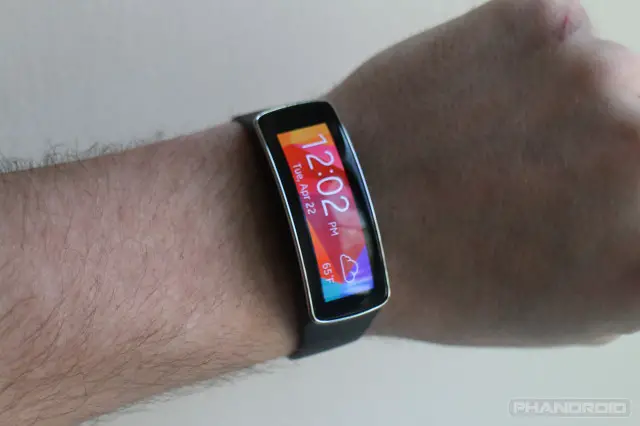
What we get is a device that through its design emphasizes its most appealing asset: a 1.84-inch curved AMOLED display. In fact, the Gear Fit represents perhaps the most appropriate use of curved touchscreen technology to date, one that marries form factor with aesthetics in a way that is more useful than the bowed displays of the Samsung Galaxy Round and LG G Flex smartphones that came before it. And, as can be expected from a Samsung AMOLED display, it looks pretty darn great with brilliant, eye-popping color and crisp detail.
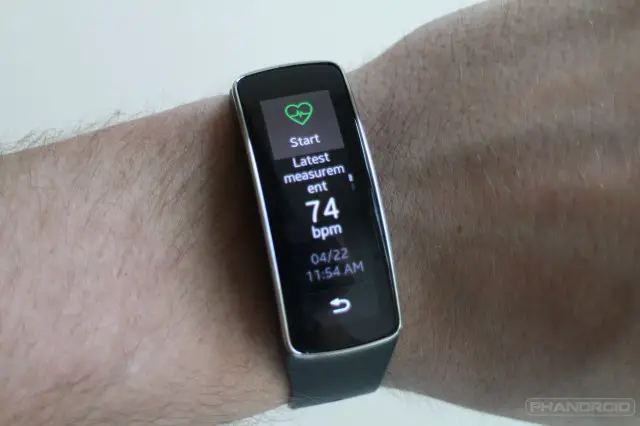
The Fit’s greatest asset, however, is also one of its biggest flaws. The unique screen design, which results in an odd resolution of 432 x 128 pixels, presents issues with the way information is displayed and presented on the Fit. The standard readout, which arranges text longways across the screen, is not suited for a quick glance at the wrist while running, cycling, or performing another fitness activity. Likewise, while opting to orient text and other data vertically (done by the flick of a settings parameter) makes it easier to consume at a glance, the display was obviously not optimized for such use. This can result in some odd text wrapping or information that gets cut off at the edges of the screen.
Beyond the display, a minimalist approach also has its drawbacks in other areas. A proprietary charging cradle is necessitated by a lack of ports on the device itself. Instead, the Fit must be charged via a set of five small contact pins on its underside. Compounding the issue is battery life that is good but not great. While two to three days of use on an average charge is solid (though not as good as the battery life of competing devices such as the FitBit), if the need arises to charge the Fit on the go — perhaps while on vacation or at work — you will need to bring along the charging cradle. It’s easy to imagine this small peripheral, essential to keeping the Fit operational, becoming lost.
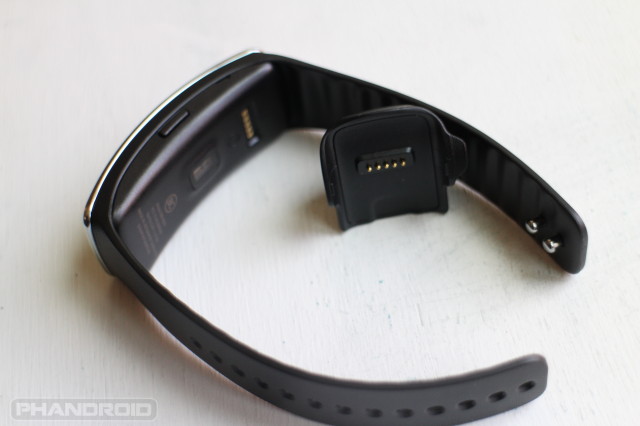
One nice addition to the fit is a built-in heart rate monitor. The sensor sits on the underside of the the fit and makes contact with the wearer’s wrist, reading heart rate info on command. After using the Fit, such a sensor, though finicky at times, seems like a must-have for any future fitness wearable. It’s use does require that the user stay relatively still and that the Fit maintains good contact with the skin. Better results seem to come from wearing the fit so that the heart rate monitor makes contact with the underside of the wrist.
The Fit offers a degree of water resistance, as well. While it might not be the best device to use for tracking laps in the pool, the Fit won’t sizzle out due to excessive sweat and you won’t have to worry about taking it off before hopping in the shower for a post-workout rinse.
Finally, rounding out the Gear Fit is its adjustable wristband. The rubberized band is comfortable enough and offers a decent range of sizes for the average wearer. Those with slightly thicker wrists might be out of luck, though, as the band does seem to run a bit on the small side of things. The band is easily removable to wash off sweat or swap out for any number of colored options from Samsung.
Fitness tracking that needs to shape up
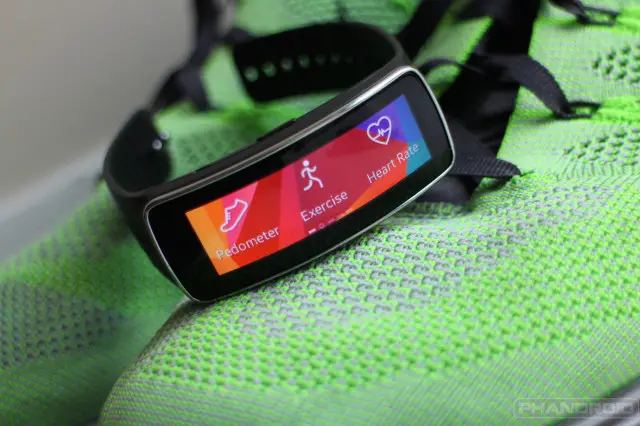
For a device with the word “fit” in its name, fitness tracking isn’t always the strong suit of the Samsung Gear Fit. Users are presented with three basic options for tracking health and fitness related activities: Pedometer, Exercise, and Sleep. As the names suggest, Pedometer tracks a user’s daily steps, Exercise provides tracking for specific activities like running, cycling, or hiking, and Sleep gathers information related to a user’s sleep patterns. Additionally users have access to a timer and stopwatch, but we’ll focus here on the modes geared toward tracking specific health and fitness data.
The pedometer does a decent job of tracking steps taken throughout the day, though it is not always the most accurate. A daily goal can be set that will congratulate the wearer when they reach a certain number of predefined steps over the course of the day. If there is a drawback to the Fit’s functionality as a pedometer it is the fact that the users must start and stop step tracking manually. The Fit will not automatically track this data as will other fitness trackers.
Likewise, users must do the same for tracking their sleep. Whereas some competing trackers will enter sleep mode automatically when they sense a user has settled down for the night, the Fit requires its wearer to manually start and stop sleep tracking. Seeing as tracking sleep cycles is probably one of the farthest things from most individual’s minds just before falling asleep and after waking, it leaves something to be desired.
As for tracking exercise, the Fit offers modes for walking, running, cycling, and hiking. Each activity provides feedback for more or less the same parameters, which include distance traveled, speed, and heart rate if selected. Once an activity is finished this data will further be crunched to provide more information like average and max speed. In Running mode, the Fit can provide coaching feedback based on heart rate. While this is more information than most basic fitness trackers provide, the modes still seem fairly limited overall.
One thinks back to Motorola’s MOTOACTV, released in 2011, and sees little advantage over what that since-dsinctonued fitness watch offered three years ago. In fact, that Motorola device included ANT+ support for connecting a variety of sensor peripherals (from heart rate monitors to step counters to cycling cadence meters) that would further add to collected data. The Gear Fit lacks support for ANT+ devices and any of the more robust fitness tracking that comes along with them.
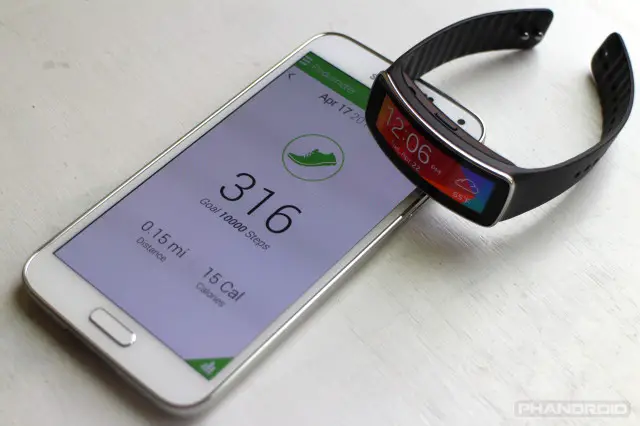
The data collected by the Gear Fit can be fed into Samsung’s S Health app on a connected Galaxy device, but it won’t offer much insight beyond what can be culled from the Fit itself. You get the same information arranged in a more visually appealing manner, but don’t expect the detailed analysis offered by Fitbit’s software and others. This makes it even more perplexing that the Fit cannot be used as a standalone device; it must be connected to a Galaxy handset during initial startup. S Health does offer some additional benefits, such as the tracking of nutrition and diet information entered by the used, and the hope is that Samsung will continue to refine and build on the experience.
The not-so-perfect smartphone companion?
The Gear Fit’s ability to sync with Galaxy smartphones elevates it from simple fitness tracker into the realm of the smartwatch, but here again the experience seems shortsighted. The fit is more a glorified notification ticker than anything else, but it’s hard to say whether this fact — at least as a concept — is necessarily good or bad.
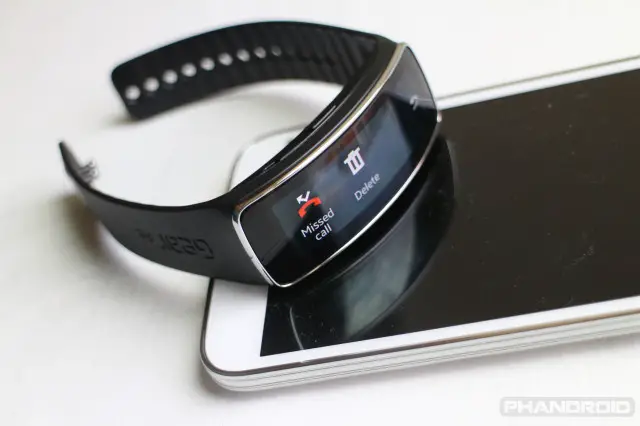
The tendency among smartwatch makers is to try to make a device limited by form do too much. With the Fit, Samsung has stripped back functionality to the bare minimum. You get alerts for missed calls, incoming texts, Facebook likes, and more, but the degree of interaction is relegated to the ability to read a message or other basic information related to a notification. After receiving an alert, there is little a user can do beyond dismissing it.
For the Fit’s design this makes sense. It would be near impossible to type a response to a text; including a microphone, speaker, or headset jack would complicate the device’s simple build. But even in representing notifications in their most basic form the Fit falters, again in no small part thanks to the dimensions of its display. When arranged horizontally information is hard to access at a glance. When arranged vertically text is wrapped in an odd manner.
Beyond this, the Fit offers two other ways to interface with your smartphone. The first is Find My Device, which will trigger the ringer of a lost phone to help the user locate it. The second is Media Controller, which offers playback controls for media stored on a Galaxy device. The crux to this, of course, is the fact that you will still need to carry that Galaxy device in order to enjoy this experience. This isn’t always ideal when taking a run or doing other strenuous fitness activities.
Samsung Gear Fit — The Bottom Line
The Samsung Gear Fit offers a simplified fitness tracker/smartwatch experience that manages to under-deliver without over-promising. By attempting to cram smartwatch functionality into a basic fitness tracker, and, as a result, neither aspect flourishes. In a rare instance for Samsung these days, design is actually the one area where the Gear Fit gets things right with a nice (if at times hampered by its dimensions) curved AMOLED display and solid build.
Should you buy it? For its price of $199, Samsung gives few compelling reasons to choose their device over cheaper alternatives from FitBit, Jawbone, and others that offer more or less the same fitness tracking capabilities. Even if a user wants the device for its direct integration with Galaxy smartphones, the more advanced Gear 2 Neo can be had for the same price.
The Good:
- Clean, attractive design
- Sharp and colorful curved AMOLED display
- Heart rate sensor is a nice addition
The Bad:
- Display orientation is not ideal
- Fitness tracking is limited, at times inaccurate
- No ANT+
- Smartphone integration leaves something to be desired
- Better options exist for the same price or cheaper
Overall: 2.5/5

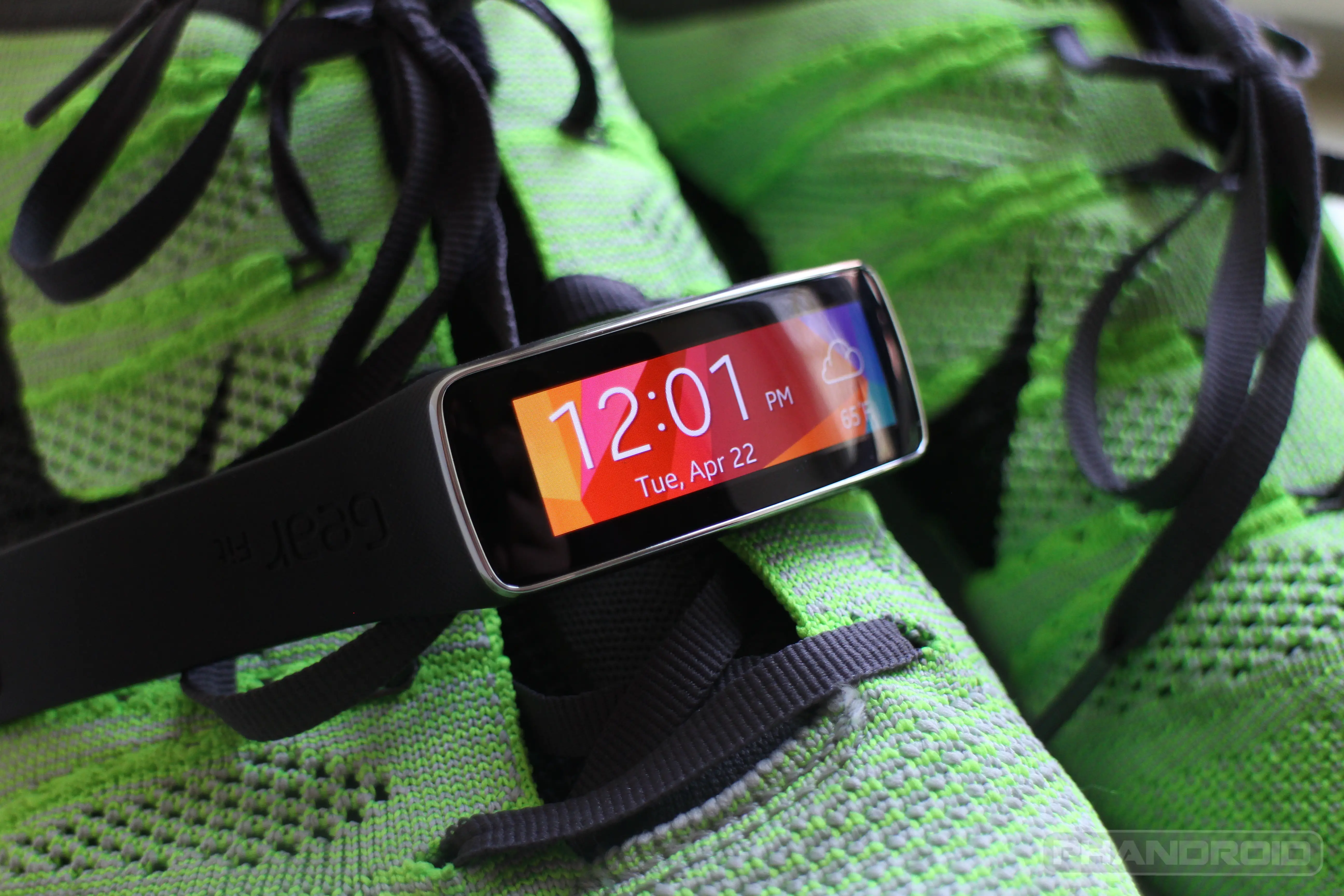
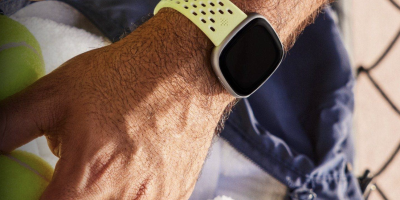

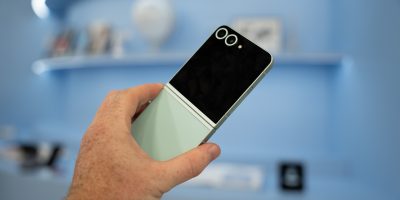
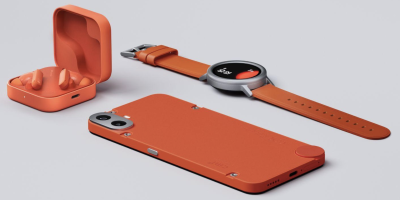
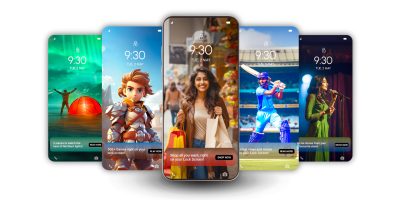





I’ll pass on this, like you said the fit bit and jawbone do more as far as the fitness tracking is concerned and that’s the thing that I care most about on a fitness band
I’ll maybe use this if I get one for free.. and it’s a huge maybe.
The Basis Fitness tracker watch has a much better heart rate sensor system.
—
I got this for the notifications/media controller (& watch function, of course). Definitely not the target demographic SAMSUNG had in mind, but, this is a nice option to have vs the rest of the Smartwatch market.
Currently using this w/the M8 & G-FLEX,a quick Google search will lead to many articles regarding the limitations w/NON-SAMSUNG devices.
Ditto w/the GEAR2/NEO.
I’m probably in the minority,but, I liked the GALAXY GEAR, & the latest line from SAMSUNG.
The compatibility has improved, but, I believe SAMSUNG will open up to non-SAMSUNG devices, rather than risk being left in the dust by the competition this summer/fall.
It’s also worth checking out a new smart watch to launch this week priced at $159 from Smart Devices and offers a sleek design plus works as a phone with a built-in speaker microphone. This new model compares to the new Samsung watch at nearly half the price and is made by Smart Devices, which products have won the mobile industries’ CTIA Award for innovation.
More details on this new Smart Devices’ P1 model at — iProTablet
I think this was designed to be worn on the underside of the wrist from day one. That makes the display make sense, as well as the fact that the heart rate monitor will work better
This product needs improvement, but most will soon be fixed by software updates.
The review would most likely have completely different words (superlatives) if it had a fruit logo, since it’s reviewed by a Apple-fan. For a new product this is really good and worth at least 4/5, if this site can’t get someone with Android preferences to review – it should at least change name and stop letting reviewers who thinks google+ is dead review anything but overpriced apple products.